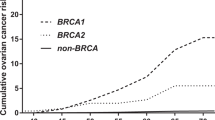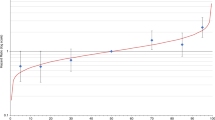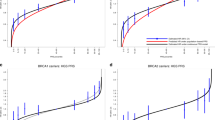Abstract
Mutations in the BRCA1 and BRCA2 genes confer a high lifetime risk of breast and ovarian cancer. The risk varies from individual to individual, and it appears that the risk has increased in recent generations. These observations imply that non-genetic factors may modify the inherited risk. To date, the factors that appear most strongly to modify the risk include reproductive histories and exogenous hormones. Oral contraceptives are associated with a profound reduction in the risk of ovarian cancer, and with little or no increase in the risk of breast cancer. Other modifying factors include age of menarche, parity, breastfeeding and oophorectomy. The effect of parity is different in BRCA1 and BRCA2 carriers. Multiparity appears to be protective in BRCA1 carriers, but is associated with an increase in risk in BRCA2 carriers. Oophorectomy has been associated with reductions in both the risk of breast and ovarian cancer. Knowledge of these risk factors will be useful for managing risk and for developing prevention strategies.
This is a preview of subscription content, access via your institution
Access options
Subscribe to this journal
Receive 50 print issues and online access
$259.00 per year
only $5.18 per issue
Buy this article
- Purchase on Springer Link
- Instant access to full article PDF
Prices may be subject to local taxes which are calculated during checkout
Similar content being viewed by others
References
Antoniou A, Pharoah PD, Narod S, Risch HA, Eyfjord JE, Hopper JL et al. (2003). Average risks of breast and ovarian cancer associated with BRCA1 or BRCA2 mutations detected in case series unselected for family history: a combined analysis of 22 studies. Am J Hum Genet 72: 1117–1130.
Cullinane CA, Lubinski J, Neuhausen SL, Ghadirian P, Lynch HT, Isaacs C . (2005). Effect of pregnancy as a risk factor for breast cancer in BRCA1/BRCA2 mutation carriers. Int J Cancer 117: 988–991.
Early Breast Cancer Trialists' Collaborative Group (1998). Tamoxifen for early breast cancer: an overview of the randomized trials. Lancet 351: 1451–1467.
Eisen A, Lubinski J, Klijn J, Moller P, Lynch HT, Offit K et al. (2005). Breast cancer risk following bilateral oophorectomy in BRCA1 and BRCA2 mutation carriers: an international case–control study. J Clin Oncol 23: 7491–7496.
Fisher B, Constantino JP, Wickerham DL, Cecchini RS, Cronin WM, Robidoux A et al. (1998). Tamoxifen for prevention of breast cancer; report of the National Surgical Adjuvant Breast and Bowel Project P-1 Study. J Natl Cancer Inst 90: 1371–1388.
Friedman E, Kotsopoulos J, Lubinski J, Lynch HT, Ghadirian P, Neuhausen SL . (2006). Spontaneous and therapeutic abortions and the risk of breast cancer among BRCA mutation carriers. Breast Cancer Res 8: R15 [E-pub ahead of print].
Ford D, Easton DF, Stratton M, Narod S, Goldgar D, Devilee P et al. (1998). Genetic heterogeneity and penetrance analysis of the BRCA1 and BRCA2 genes in breast cancer families. Breast Cancer Linkage Consortium. Am J Hum Genet 62: 676–689.
Gayther SA, Warren W, Mazoyer S, Russell PA, Harrington PA, Chiano M et al. (1995). Germline mutations of the BRCA1 gene in breast and ovarian cancer families provide evidence for a genotype–phenotype correlation. Nat Genet 11: 428–433.
Gronwald J, Tung N, Foulkes WD, Offit K, Gershoni R, Daly M, et al., Hereditary Breast Cancer Clinical Study Group. (2006). Tamoxifen and contralateral breast cancer in BRCA1 and BRCA2 carriers: an update. Int J Cancer 118: 2281–2284.
Jernstrom H, Klug TL, Sepkovic DW, Bradlow HL, Narod SA . (2003). Predictors of the plasma ratio of 2-hydroxyestrone to 16alpha-hydroxyestrone among pre-menopausal, nulliparous women from four ethnic groups. Carcinogenesis 24: 991–1005.
Jernstrom H, Lubinksi J, Lynch HT, Ghadirian P, Neuhausen S, Isaacs C et al. (2004). Breast-feeding and the risk of breast cancer in BRCA1 and BRCA2 mutation carriers. J Natl Cancer Inst 96: 209–214.
Kauff ND, Satagopan JM, Robson ME, Scheuer L, Hensley M, Hudis CA et al. (2002). Risk-reducing salpingo-oophorectomy in women with a BRCA1 or BRCA2 mutation. N Engl J Med 346: 1609–1615.
King MC, Marks JH, Mandell JB, New York Breast Cancer Study Group. (2003). Breast and ovarian cancer risks due to inherited mutations in BRCA1 and BRCA2. Science 302: 643–646.
King MC, Wieand S, Hale K, Lee M, Walsh T, Owens K et al. (2001). Tamoxifen and breast cancer incidence among women with inherited mutations in BRCA1 and BRCA2. National Surgical Adjuvant Breast and Bowel Project (NSABP-P1) Breast Cancer Prevention Trial. J Am Med Assoc 286: 2251–2256.
Kotsopoulos J, Lubinski J, Lynch HT, Neuhausen SL, Ghadirian P, Isaacs C et al. (2005). Age at menarche and the risk of breast cancer in BRCA1 and BRCA2 mutation carriers. Cancer Causes Control 16: 667–674.
Kotsopoulos J, Lubinski J, Lynch HT, Neuhausen SL, Ghadirian P, Isaacs C et al. (2006). Age at first birth and the risk of breast cancer in BRCA1 and BRCA2 mutation carriers (submitted).
Kotsopoulos J, Narod SA . (2005). Towards a dietary prevention of hereditary breast cancer. Cancer Causes Control 16: 125–138.
Kowalska E, Narod SA, Huzarski T, Zajaczek S, Huzarska J, Gorski B et al. (2005). Increased rates of chromosome breakage in BRCA1 carriers are normalized by oral selenium supplementation. Cancer Epidemiol Biomarkers Prev 14: 1302–1306.
Levy-Lahad E, Catane R, Eisenberg S, Kaufman B, Hornreich G, Lishinsky E et al. (1997). Founder BRCA1 and BRCA2 mutations in Ashkenazi Jews in Israel: frequency and differential penetrance in ovarian cancer and in breast-ovarian cancer families. Am J Hum Genet 60: 1059–1067.
Mazoyer S, Dunning AM, Serova O, Dearden J, Puget N, Healey CS et al. (1996). A polymorphic stop codon in BRCA2. Nat Genet 14: 253–254.
Meijers-Heijboer H, van Geel B, van Putten WL, Henzen-Logmans SC, Seynaeve C, Menke-Pluymers MB et al. (2001). Breast cancer after prophylactic bilateral mastectomy in women with a BRCA1 or BRCA2 mutation. N Engl J Med 345: 159–164.
Narod SA, Dube MP, Klijn J, Lubinski J, Lynch HT, Ghadirian P et al. (2002). Oral contraceptives and the risk of breast cancer in BRCA1 and BRCA2 mutation carriers. J Natl Cancer Inst 94: 1773–1779.
Narod SA, Lynch H, Conway T, Watson P, Feunteun J, Lenoir G . (1993). Increasing incidence of breast cancer in family with BRCA1 mutation. Lancet 341: 1101–1102.
Narod SA, Risch H, Moslehi R, Dorum A, Neuhausen S, Olsson H et al. (1998). Oral contraceptives and the risk of hereditary ovarian cancer. N Engl J Med 339: 424–428.
Nkondjock A, Ghadirian P, Kotsopoulos J, Lubinski J, Lynch H, Kim-Sing C et al. (2006). Coffee consumption and breast cancer risk among BRCA1 and BRCA2 mutation carriers. Int J Cancer 18: 1852.
Phelan CM, Rebbeck TR, Weber BL, Devilee P, Ruttledge MH, Lynch HT et al. (1996). Ovarian cancer risk in BRCA1 carriers is modified by the HRAS1 variable number of tandem repeat (VNTR) locus. Nature Genet 12: 309–311.
Rebbeck TR, Friebel T, Wagner T, Lynch HT, Garber JE, Daly MB, et al., PROSE Study Group. (2005). Effect of short-term hormone replacement therapy on breast cancer risk reduction after bilateral prophylactic oophorectomy in BRCA1 and BRCA2 mutation carriers: the PROSE Study Group. J Clin Oncol 23: 7804–7810.
Rebbeck TR, Kantoff PW, Krithivas K, Neuhausen S, Blackwood MA, Godwin AK et al. (1999). Modification of BRCA1-associated breast cancer risk by the polymorphic androgen-receptor CAG repeat. Am J Hum Genet 64: 1371–1377.
Rebbeck TR, Levin AM, Eisen A, Snyder C, Watson P, Cannon-Albright L et al. (1999). Breast cancer risk after bilateral prophylactic oophorectomy in BRCA1 mutation carriers. J Natl Cancer Inst 91: 1475–1479.
Rebbeck TR, Wang Y, Kantoff PW, Krithivas K, Neuhausen SL, Godwin AK et al. (2001). Modification of BRCA1- and BRCA2-associated breast cancer risk by AIB1 genotype and reproductive history. Cancer Res 61: 5420–5424.
Risch HA, McLaughlin JR, Cole DE, Rosen B, Bradley L, Kwan E et al. (2001). Prevalence and penetrance of germline BRCA1 and BRCA2 mutations in a population series of 649 women with ovarian cancer. Am J Hum Genet 68: 700–710.
Runnebaum IB, Wang-Gohrke S, Vesprini D, Kreienberg R, Lynch H, Moslehi R et al. (2001). Progesterone receptor variant increases ovarian cancer risk in BRCA1 and BRCA2 mutation carriers who were never exposed to oral contraceptives. Pharmacogenetics 11: 635–638.
Russo J, Lynch H, Russo IH . (2001). Mammary gland architecture as a determining factor in the susceptibility of the human breast to cancer. Breast J 7: 277.
Russo J, Rivera J, Russo IH . (1992). Influence of age and parity on the development of the human breast. Breast Cancer Res and Treat 23: 211–218.
The Breast Cancer Linkage Consortium (1999). Cancer risks in BRCA2 mutation carriers. J Natl Cancer Inst 91: 1310–1316.
Thompson D, Easton D, Breast Cancer Linkage Consortium. (2001). Variation in cancer risks, by mutation position, in BRCA2 mutation carriers. Am J Hum Genet 68: 410–419.
Thorlacius S, Sigurdsson S, Bjarnadottir H, Olafsdottir G, Jonasson JG, Tryggvadottir L et al. (1997). Study of a single BRCA2 mutation with high carrier frequency in a small population. Am J Hum Genet 60: 1079–1084.
Tryggvadottir L, Sigvaldason H, Olafsdottir GH, Jonasson JG, Jonsson T, Tulinius H et al. (2006). Population-based study of changing breast cancer risk in Icelandic BRCA2 mutation carriers, 1920–2000. J Natl Cancer Inst 98: 116–122.
Weitzel JN, Robson M, Pasini B, Manoukian S, Stoppa-Lyonnet D, Lynch HT et al. (2005). A comparison of bilateral breast cancers in BRCA carriers. Cancer Epidemiol Biomarkers Prev 14: 1534–1538.
Author information
Authors and Affiliations
Corresponding author
Rights and permissions
About this article
Cite this article
Narod, S. Modifiers of risk of hereditary breast cancer. Oncogene 25, 5832–5836 (2006). https://doi.org/10.1038/sj.onc.1209870
Published:
Issue Date:
DOI: https://doi.org/10.1038/sj.onc.1209870
Keywords
This article is cited by
-
Choices for cancer prevention for women with a BRCA1 mutation? a personal view
Hereditary Cancer in Clinical Practice (2023)
-
Can harmful lifestyle, obesity and weight changes increase the risk of breast cancer in BRCA 1 and BRCA 2 mutation carriers? A Mini review
Hereditary Cancer in Clinical Practice (2021)
-
Counselling interventions to enable women to initiate and continue breastfeeding: a systematic review and meta-analysis
International Breastfeeding Journal (2019)
-
HDAC9 Polymorphism Alters Blood Gene Expression in Patients with Large Vessel Atherosclerotic Stroke
Translational Stroke Research (2019)
-
Investigating the effects of additional truncating variants in DNA-repair genes on breast cancer risk in BRCA1-positive women
BMC Cancer (2019)



